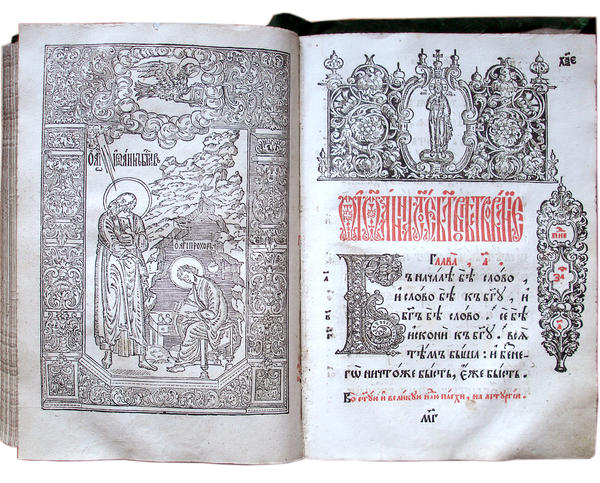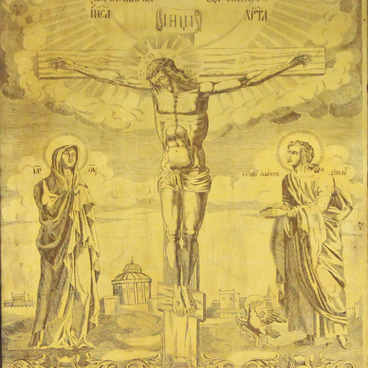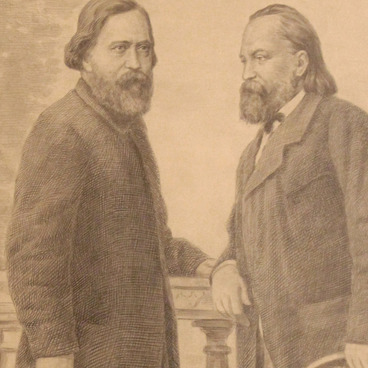The Altar Gospel entered the I.D. Voronin United Museum of Local History of the Republic of Mordovia (I.D. Voronin NMLHRM) in 1938 from the Apostle John Church, which was built in 1693 on the site of an old wooden church as a parish in the Streletskaya settlement of Saransk. This is the oldest building in Mordovia.
In Soviet times, the church was to be demolished, but the parishioners were able to defend it. Until February 1944, the NKVD archive was located here, but then the church was opened to the faithful and for a long time remained the only functioning Orthodox Church in Saransk. The church of John the Apostle is an architectural monument of federal importance, entered into the register by the resolution of the Council of Ministers of the RSFSR in 1960. From 1991 to 2006, it served as a cathedral church of Saransk and Mordovia.
The altar gospel is a worship book containing the text of the four Gospels (Matthew, Mark, John, and Luke) and a schedule of liturgical readings. The presented altar gospel is printed on Dutch paper with Foolscap watermarks (deuce’s head in a scalloped cape) and Amsterdam (coat of arms of the city of Amsterdam). Despite the fact that paper production appeared in Russia in the 60s of the 16th century, Dutch paper was still more popular. Appearing on the Russian book market in the second half of the 17th century, it quickly replaced all other materials.
The title page of the Gospel is decorated with ornamental frames, the text is supplemented with images of the events of the earthly life of Jesus Christ and engravings of the gospellers. The image “God Almighty” was drawn by the elder Paisius, engravings of gospeller John-Fyodor Zubov, the image of gospeller Luke-Sergey Avramov, and the boards were cut by hieromonch Joasaph and A. Nefedyev.
The ornament of the Gospel consists of initials, images and frames for marginal notes - drawings containing comments and interpretations on fragments of the text. An important entry is written on the margins of the Gospel on pages 25 to 47: “7186 (1678) year March 19 this book the Holy Gospel is attached to the Church of John the Apostle in Saransk city”. The binding of the Gospel is made of wood covered with green velvet. It was made later – in the 19th century. The book edge is decorated with gold with chasing.
During the reforms of Patriarch Nikon (1605-1681), in the preface and afterword editions of the Moscow printing house – the first Russian printing house, it was indicated that the texts correspond to ancient Greek books. But they were amended on the basis of modern Greek editions, which often did not coincide with the oldest manuscripts. The fact that the presented altar Gospel is printed from the corrected text is evidenced by the quadrangular crosses at the top of the book images.
In Soviet times, the church was to be demolished, but the parishioners were able to defend it. Until February 1944, the NKVD archive was located here, but then the church was opened to the faithful and for a long time remained the only functioning Orthodox Church in Saransk. The church of John the Apostle is an architectural monument of federal importance, entered into the register by the resolution of the Council of Ministers of the RSFSR in 1960. From 1991 to 2006, it served as a cathedral church of Saransk and Mordovia.
The altar gospel is a worship book containing the text of the four Gospels (Matthew, Mark, John, and Luke) and a schedule of liturgical readings. The presented altar gospel is printed on Dutch paper with Foolscap watermarks (deuce’s head in a scalloped cape) and Amsterdam (coat of arms of the city of Amsterdam). Despite the fact that paper production appeared in Russia in the 60s of the 16th century, Dutch paper was still more popular. Appearing on the Russian book market in the second half of the 17th century, it quickly replaced all other materials.
The title page of the Gospel is decorated with ornamental frames, the text is supplemented with images of the events of the earthly life of Jesus Christ and engravings of the gospellers. The image “God Almighty” was drawn by the elder Paisius, engravings of gospeller John-Fyodor Zubov, the image of gospeller Luke-Sergey Avramov, and the boards were cut by hieromonch Joasaph and A. Nefedyev.
The ornament of the Gospel consists of initials, images and frames for marginal notes - drawings containing comments and interpretations on fragments of the text. An important entry is written on the margins of the Gospel on pages 25 to 47: “7186 (1678) year March 19 this book the Holy Gospel is attached to the Church of John the Apostle in Saransk city”. The binding of the Gospel is made of wood covered with green velvet. It was made later – in the 19th century. The book edge is decorated with gold with chasing.
During the reforms of Patriarch Nikon (1605-1681), in the preface and afterword editions of the Moscow printing house – the first Russian printing house, it was indicated that the texts correspond to ancient Greek books. But they were amended on the basis of modern Greek editions, which often did not coincide with the oldest manuscripts. The fact that the presented altar Gospel is printed from the corrected text is evidenced by the quadrangular crosses at the top of the book images.



